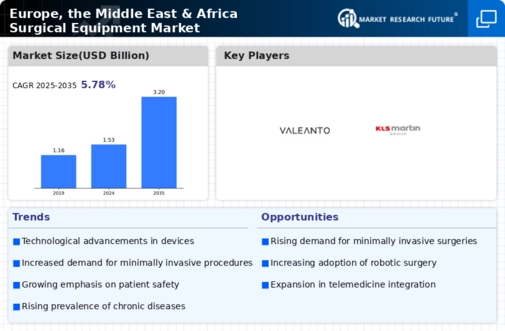-
Definition
-
Scope of the Study
- Research Objective
- Assumptions
- Limitations
-
Introduction
-
Primary Research
-
Secondary research
-
Market Size Estimation
-
Drivers
-
Restrains
-
Opportunities
-
Challenges
-
Macroeconomic Indicators
-
Technology Trends & Assessment
-
Porters Five Forces Analysis
- Bargaining Power of Suppliers
- Bargaining Power of Buyers
- Threat of New Entrants
- Threat of Substitutes
- Intensity of Rivalry
-
Value Chain Analysis
-
Investment Feasibility Analysis
-
Pricing Analysis
-
Chapter 6. EMEA Surgical Equipment Market, by Product Type
-
Introduction
-
Surgical Sutures and Staples
-
Market Estimates & Forecast, 2023-2032
-
Handheld Surgical Equipment
- Forceps and Spatulas
- Retractors
- Dilators
- Graspers
- Auxiliary Instruments
- Cutter Instruments
-
Market Estimates & Forecast, 2023-2032
-
Electrosurgical Devices
- Electro Surgical Generators
- Bipolar Instruments
- Monopolar Instruments
-
Market Estimates & Forecast, 2023-2032
-
Others
-
Chapter 7. EMEA Surgical Equipment Market, by Application
-
Introduction
-
Neurosurgery
-
Market Estimates & Forecast, 2023-2032
-
Obstetrics and Gynecology
-
Market Estimates & Forecast, 2023-2032
-
Orthopedic Surgery
-
Market Estimates & Forecast, 2023-2032
-
Cardiovascular Surgery
-
Market Estimates & Forecast, 2023-2032
-
Others
-
Chapter 8 EMEA Surgical Equipment Market, by End Users
-
Introduction
-
Hospitals & Clinics
-
Market Estimates & Forecast, 2023-2032
-
Research Organizations
-
Market Estimates & Forecast, 2023-2032
-
Academic Institutes
-
Market Estimates & Forecast, 2023-2032
-
Others
-
Chapter 9. EMEA Surgical Equipment Market, by Region
-
Introduction
-
Europe
- Western Europe
- Eastern Europe
-
The Middle East & Africa
- United Arab Emirates
- Saudi Arabia
- Oman
- Kuwait
- Qatar
- Rest of the Middle East & Africa
-
Chapter 10 Company Landscape
-
Introduction
-
Market Share Analysis
-
Key Development & Strategies
- Key Developments
-
Chapter 11 Company Profiles
-
Smith & Nephew
- Company Overview
- Product Overview
- Financials Overview
- Key Developments
- SWOT Analysis
-
B. Braun Melsungen AG
- Company Overview
- Product Overview
- Financial Overview
- Key Developments
- SWOT Analysis
-
Erbe Elektromedizin GmbH
- Company Overview
- Product Overview
- Financial Overview
- Key Development
- SWOT Analysis
-
Ethicon US, LLC.
- Company Overview
- Product/Business Segment Overview
- Financial Overview
- Key Development
- SWOT Analysis
-
COVIDIEN.
- Company Overview
- Product Overview
- Financial overview
- Key Developments
- SWOT Analysis
-
CONMED Corporation.
- Company Overview
- Product Overview
- Financial Overview
- Key Developments
- SWOT Analysis
-
Integra LifeSciences Corporation.
- Overview
- Product Overview
- Financials
- Key Developments
- SWOT Analysis
-
Valeant.
- Overview
- Product Overview
- Financials
- Key Developments
- SWOT Analysis
-
KLS Martin Group
- Overview
- Product Overview
- Financials
- Key Developments
- SWOT Analysis
-
Others
-
Chapter 12 MRFR Conclusion
-
Key Findings
- From CEO’s View Point
- Unmet Needs of the Market
-
Key Companies to Watch
-
Prediction of cancer industry
-
Chapter 13 Appendix
-
LIST OF TABLES
-
Surgery Equipment Industry Synopsis, 2023-2032
-
EMEA Surgical Equipment Market Estimates and Forecast, 2023-2032, (USD Million)
-
EMEA Surgical Equipment Market by Region, 2023-2032, (USD Million)
-
EMEA Surgical Equipment Market by Product Type, 2023-2032, (USD Million)
-
EMEA Surgical Equipment Market by Application, 2023-2032, (USD Million)
-
EMEA Surgical Equipment Market by End Users, 2023-2032, (USD Million)
-
Europe Surgical Equipment Market by Product Type, 2023-2032, (USD Million)
-
Europe Surgical Equipment Market by Application, 2023-2032, (USD Million)
-
Europe Surgical Equipment Market by End Users, 2023-2032, (USD Million)
-
Western Europe Surgical Equipment Market by Product Type, 2023-2032, (USD Million)
-
Western Europe Surgical Equipment Market by Application, 2023-2032, (USD Million)
-
Western Europe Surgical Equipment Market by End Users, 2023-2032, (USD Million)
-
Eastern Europe Surgical Equipment Market by Product Type, 2023-2032, (USD Million)
-
Eastern Europe Surgical Equipment Market by Application, 2023-2032, (USD Million)
-
Eastern Europe Surgical Equipment Market by End Users, 2023-2032, (USD Million)
-
Middle East & Africa Surgical Equipment Market by Product Type, 2023-2032, (USD Million)
-
Middle East & Africa Surgical Equipment Market by Application, 2023-2032, (USD Million)
-
Middle East & Africa Surgical Equipment Market by End Users, 2023-2032, (USD Million)
-
LIST OF FIGURES
-
Research Process
-
Segmentation for EMEA Surgical Equipment Market
-
Market Dynamics for EMEA Surgical Equipment Market
-
EMEA Surgical Equipment Market Share, by Product Type 2023
-
EMEA Surgical Equipment Market Share, by Application 2023
-
EMEA Surgical Equipment Market Share, by End Users, 2023
-
EMEA Surgical Equipment Market Share, by Region, 2023
-
Europe Surgical Equipment Market Share, by Country, 2023
-
Middle East & Africa Surgical Equipment Market Share, by Country, 2023
-
EMEA Surgical Equipment Market: Company Share Analysis, 2023 (%)
-
Smith & Nephew: Key Financials
-
Smith & Nephew: Segmental Revenue
-
Smith & Nephew: Geographical Revenue
-
B. Braun Melsungen AG: Key Financials
-
B. Braun Melsungen AG: Segmental Revenue
-
B. Braun Melsungen AG: Geographical Revenue
-
Erbe Elektromedizin GmbH: Key Financials
-
Erbe Elektromedizin GmbH: Segmental Revenue
-
Erbe Elektromedizin GmbH: Geographical Revenue
-
Ethicon US, LLC.: Key Financials
-
Ethicon US, LLC.: Segmental Revenue
-
Ethicon US, LLC.: Geographical Revenue
-
COVIDIEN: Key Financials
-
COVIDIEN: Segmental Revenue
-
COVIDIEN: Geographical Revenue
-
CONMED Corporation.: Key Financials
-
CONMED Corporation.: Segmental Revenue
-
CONMED Corporation.: Geographical Revenue
-
Integra LifeSciences Corporation.: Key Financials
-
Integra LifeSciences Corporation.: Segmental Revenue
-
Integra LifeSciences Corporation.: Geographical Revenue
-
Valeant.: Key Financials
-
Valeant.: Segmental Revenue
-
Valeant.: Geographical Revenue
-
KLS Martin Group: Key Financials
-
KLS Martin Group: Segmental Revenue
-
KLS Martin Group: Geographical Revenue














Leave a Comment